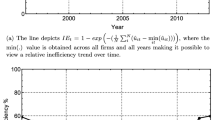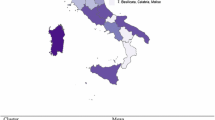Abstract
The introduction of prospective hospital reimbursement based on diagnosis-related groups (DRG) has been a conspicuous attempt to decelerate the steady increase of hospital expenditures in the German health sector. In this work, the effect of the financial reform on hospital efficiency is subjected to empirical testing by means of two complementary testing approaches. On the one hand, we apply a two-stage procedure based on non-parametric efficiency measurement. On the other hand, a stochastic frontier model is employed that allows a one-step estimation of both production frontier parameters and inefficiency effects. To identify efficiency gains as a consequence of changes in the hospital incentive structure, we account for technological progress, spatial dependence and hospital heterogeneity. The results of both approaches do not reveal any increase in overall efficiency after the DRG reform. In contrast, a significant decline in overall hospital efficiency over time is observed.
Similar content being viewed by others
Notes
Hospitals are treated as an inefficient outlier if a convex combination of worst performing hospitals can produce the same level of output using half the inputs. An efficient outlier is detected if it is possible to double the inputs without becoming inefficient. As it turns out, diagnostic results are qualitatively very similar across alternative threshold values for outlier detection.
Regarding the applied two-stage approach, some remarks are in order. In the second-stage regression analysis, the logarithmic transformation of the pure technical efficiency change, γ it , ensures an unbounded dependent variable and thus enables a consistent maximum likelihood estimation [39]. However, Simar and Wilson [39] mention that in finite samples the estimated DEA efficiency scores are biased and serially correlated in a complicated fashion. This invalidates standard approaches to inference, e.g., based on the inverse of the negative Hessian of the log-likelihood. Maximum likelihood estimates of regressions involving DEA efficiency scores are consistent, but inference based on the inverse of the negative Hessian of the log-likelihood is generally invalid. Similar concerns might be raised with regard to a second stage regression analysis of pure technical efficiency change γ it . To analyze the robustness of inferential results, we apply an adaptation of the bootstrap procedure suggested by Simar and Wilson [39]. However, the difference between bootstrap based and asymptotic results is negligible, and therefore we only document the latter.
We also estimate more parsimoniously parameterized model variants, i.e., the spatial lag model, ρ = 0, and the spatial error model, λ = 0 [1]. However, respective log-likelihood statistics are significantly smaller than the statistics of the corresponding SARAR models.
Alternatively, we estimate a model with joint dummy variables for the DRG announcement and introduction period. However, the corresponding model diagnostics suggest a strong recommendation for the specification of separate year dummy variables, indicating substantial heterogeneity of hospital efficiency over time. This result holds also for the SFA one-step estimation.
References
Anselin, L.: Spatial Econometrics: Methods and Models. Kluwer Academic Publishers, Boston (1988)
Banker, R.D., Morey, R.C.: Efficiency analysis for exogenously fixed inputs and outputs. Oper. Res. 34(4), 513–521 (1986)
Banker, R.D., Charnes, A., Cooper, W.W.: Some models for estimating technical and scale inefficiencies in data envelopment analysis. Manag. Sci. 30, 1078–1092 (1984)
Barbetta, G.P., Turati, G., Zago, A.M.: Behavioral differences between public and private not-for-profit hospitals in the Italian national health service. Health Econ. 16(1), 75–96 (2007)
Bech, M., Lauridsen, J.: Exploring the spatial pattern in hospital admissions. Health Policy 87(1), 50–62 (2008)
Berta, P., Callea, G., Martini, G., Vittadini, G.: The effects of upcoding, cream skimming and readmissions on the Italian hospitals efficiency: a population-based investigation. Econ. Model. 27, 812–821 (2010)
Biorn, E., Hagen, T.P., Iversen, T., Magnussen, J. : The effect of activity-based financing on hospital efficiency: a panel data analysis of DEA efficiency scores 1992–2000 Health Care Manag. Sci. 6, (4), 271–283 (2003)
Biorn, E., Hagen, T.P., Iversen, T., Magnussen, J. : How different are hospitals’ responses to a financial reform? The impact on efficiency of activity-based financing. Health Care Manag. Sci. 13, (1), 1–16 (2010)
Böcking, W., Ahrens, U., Kirch, W., Milakovic, M.: First results of the introduction of DRGs in Germany and overview of experience from other DRG countries. J Public Health 13(3), 128–137, (2005)
Borden, J.P.: An assessment of the impact of diagnosis-related group (Drg)-based reimbursement on the technical efficiency of New Jersey hospitals using data envelopment analysis. J. Account. Public Policy 7(2), 77–96 (1988)
Braun, T., Rau, F., Tuschen, K.H.: Die DRG-Einführung aus gesundheitspolitischer Sicht. Eine Zwischenbilanz. In: Schellschmidt H. (ed.), Krankenhaus-Report ’07. pp. 3–22. Schattauer, Stuttgart, (2008)
Burgess, J., Wilson, P.: Decomposing hospital productivity changes, 1985–1988: a nonparametric Malmquist approach. J. Prod. Anal. 6, 343–363 (1995)
Chang, H.: Determinants of hospital efficiency: the case of central government-owned Hospitals in Taiwan. Omega 26(2), 307–317 (1998)
Chern, J.-Y., Wan, T.T.: The impact of the prospective payment system on the technical efficiency of hospitals. J. Med. Syst. 24(3), 159–172 (2000)
Chua, C., Palangkaraya, A., Yong, J.: Hospital competition, technical efficiency, and quality. Econ. Rec. 87(277), 252–268 (2011)
Cooper, Z.N., Gibbons, S., Jones, S., McGuire, A.: Does Hospital Competition Improve Efficiency? An Analysis of the Recent Market-based Reforms to the English NHS, London: Centre for Economic Performance (2010)
Coulam, R., Gaumer, G.: Medicare’s prospective payment system: a critical appraisal. Health Care Financ. Rev. Annual Supplement 45–77 (1991)
Daidone S, D’Amico F.: Technical efficiency, specialization and ownership form: evidences from a pooling of Italian hospitals. J. Prod. Anal. 32(3), 203–216 (2009)
Dismuke C.E., Sena V. (1999) Has DRG payment influenced the technical efficiency and productivity of diagnostic technologies in Portuguese public hospitals? An empirical analysis using parametric and non-parametric methods. Health Care Manag. Sci. 2(2):107–116
Evans, R.G., Walker, H.D.: Information theory and the analysis of hospital cost structure. Can. J. Econ. 5(3), 398–418 (1972)
Färe, R., Grosskopf, S., Norris, M., Zhang, Z.: Productivity growth, technical progress, and efficiency change in industrialized countries. Am Econ Rev 84(1), 66–83 (1994)
Färe, R., Grosskopf, S., Lindgren, B., Roos, P.: Productivity changes in Swedish pharmacies 1980–1989: a non-parametric Malmquist approach. J. Prod. Anal. 3, 85–101 (1992)
Farsi, M., Filippini, M.: Effects of ownership, subsidization and teaching activities on hospital costs in Switzerland. Health Econ. 17(3), 335–350 (2008)
France, G., Taroni, F., Donatini, A.: The Italian health-care system. Health Econ. 14(1), 187-202 (2005)
Greene, W.: Reconsidering heterogeneity in panel data estimators of the stochastic frontier model. J. Econom. 126(2), 269–303 (2005)
Helmig, B., Lapsley, I.: On the efficiency of public, welfare and private hospitals in Germany over time—A sectoral DEA-study. Health Serv. Manag. Res. 14(4), 263-274 (2001)
Hensen, P., Beissert, S., Bruckner-Tuderman, L., Luger, T.A., Roeder, N., Müller, M.L.: Introduction of diagnosis-related groups in Germany: evaluation of impact on in-patient care in a dermatological setting. Eur. J. Public Health 18(1), 85–91 (2008)
Herr, A.: Cost and technical efficiency of German hospitals: does ownership matter? Health Econ. 17(9), 1057–1071 (2008)
Herr, A., Schmitz, H., Augurzky, B.: Profit efficiency and ownership of German hospitals. Health Econ. 20(6), 660–674 (2011)
Herwartz, H., Strumann, C.: On the effect of prospective payment on local hospital competition in Germany. Health Care Manag. Sci. 15(1), 48–62 (2012)
Jacobs, R.: Alternative methods to examine hospital efficiency: data envelopment analysis and Stochastic Frontier analysis. Health Care Manag. Sci. 4(2), 103–115 (2001)
Jacobs, R., Smith, P.C., Street, A.: Measuring Efficiency in Health Care: Analytic Techniques and Health Policy. Cambridge University Press, Cambridge (2006)
Johnson, A.L., McGinnis, L.F.: Outlier detection in two-stage semiparametric DEA models. Eur. J. Oper. Res. 187(2), 629–635 (2008)
Kumbhakar, S.C., Ghosh, S., McGuckin, J.T.: A generalized production frontier approach for estimating determinants of inefficiency in U.S. dairy farms. J. Bus. Econ. Stat. Am. Stat. Assoc. 9(3), 279–286 (1991)
Lee, K., Chun, K., Lee, J.: Reforming the hospital service structure to improve efficiency: urban hospital specialization. Health Policy 87(1), 41–49 (2008)
Levaggi, R., Montefiori M.: Horizontal and vertical cream skimming in the health care market. DISEFIN Working Paper No. 11/2003 (2003)
Linna, M.: Health care financing reform and the productivity change in Finnish hospitals. J. Health Care Financ. 26(3), 83–100 (2000)
Lungen, M., Lapsley, I.: The reform of hospital financing in Germany: an international solution?. J. Health Organ. Manag. 17(5), 360–372 (2003)
Simar, L., Wilson, P.W.: Estimation and inference in two-stage, semi-parametric models of production processes. J. Econom. 136(1), 31–64 (2007)
Simborg, D.W.: DRG creep: a new hospital-acquired disease. N. Engl. J. Med. 304(26), 1602–1604 (1981)
Sommersguter-Reichmann, M.: The impact of the Austrian hospital financing reform on hospital productivity: empirical evidence on efficiency and technology changes using a non-parametric input-based Malmquist approach. Health Care Manag. Sci. 3(4), 309–321 (2000)
Staat, M.: Efficiency of hospitals in Germany: a DEA-bootstrap approach. Appl. Econ. 38(19), 2255–2263 (2006)
Staat, M., Hammerschmidt, M.: Benchmarking the Health Sector in Germany—An Application of Data Envelopment Analysis. Research paper, Institute for Market-Oriented Management, University Mannheim (2003)
Statistisches Bundesamt (2012). Gesundheit—Kostennachweis der Krankenhäuser. Fachserie 12 Reihe 6.3, Wiesbaden 2012
Tiemann, O., Schreyögg, J.: Changes in hospital efficiency after privatization. Health Care Manag. Sci. 15(4), 310–326 (2012)
Tiemann, O., Schreyögg, J.: Effects of ownership on hospital efficiency in Germany. BuR Bus. Res. J. 2(2), 115–145 (2009)
Wang, H.-J., Ho, C.-W.: Estimating fixed-effect panel stochastic frontier models by model transformation. J. Econom. 157(2):286–296 (2010)
Wang, H.-J., Schmidt, P.: One-step and two-step estimation of the effects of exogenous variables on technical efficiency levels. J. Prod. Anal. 18(2), 129–144 (2002)
Werblow, A., Karmann, A., Robra, B.P.: Effizienz, Wettbewerb und regionale Unterschiede in der stationären Versorgung. In: Klauber, J., Geraedts, M., Friedrich, J. (eds.) Krankenhaus-Report 2010—Schwerpunkt: Krankenhausversorgung in der Krise? (Stuttgart, Schattauer), pp. 41–71 (2010)
Werblow, A., Robra, B.P.: Einsparpotenziale im medizinfernen Bereich deutscher Krankenhäuser—eine regionale Effizienzfront-Analyse. In: Klauber, J., Schellschmidt, H., Robra, B.P. (eds.) Krankenhaus-Report 2006—Schwerpunkt: Krankenhausmarkt im Umbruch (Stuttgart, Schattauer), pp. 133–151 (2007)
Wilson, P.W.: Detecting influential observations in data envelopment analysis. J. Prod. Anal. 6(1), 27–45 (1995)
Zweifel, P., Breyer, F., Kifmann, M.: Health Economics. Springer, Berlin (2009)
Acknowledgments
We thank two anonymous referees, Uwe Jensen, Andrew Street, the participants in the “10 Jahre Forschungsdatenzentren” conference of the Statistischen Ämter des Bundes und der Länder 2012 in Berlin, dggö—Jahrestagung 2011 in Bayreuth and Jahrestagung des Vereins für Socialpolitik 2010 in Kiel for helpful comments and discussions on earlier versions of this manuscript. We also thank the employees of the Forschungsdatenzentrum der Statistischen Landesämter-Standort Kiel/Hamburg for their cooperation.
Author information
Authors and Affiliations
Corresponding author
Appendices
Appendix 1: DEA efficiency scores
The efficiency score, θ v i , is obtained under the assumption of variable returns to scale [3] by solving the following linear program
where q ri , x N ji and x D ki denote output, non-discretionary and discretionary input variables of hospital i. The numbers of outputs, non- and discretionary inputs, and reference hospitals are s, m N, m D, and N, respectively.
Appendix 2: Second-stage maximum likelihood estimation
The (unbalanced) model can be written in matrix notation as
where \(y = \left(y_1^{\prime},\ldots, y_T^{\prime}\right)^{\prime}, {\user2{Z}}=\left({\user2{Z}}_1^{\prime},\ldots, {\user2{Z}}_T^{\prime}\right)^{\prime},\,e=\left(e_1^{\prime},\ldots, e_T^{\prime}\right)^{\prime}\) and \(\epsilon=\left(\epsilon_1^{\prime},\ldots, \epsilon_T^{\prime}\right)^{\prime}\). The coefficients of the time dummy variables, δ t , are collected in \(\delta = \left(\delta_2 ,\ldots, \delta_T\right)^{\prime}, \) where t = 1 is the benchmark, \({\mathfrak{o}_t}\) and \(\iota_t\) is an N t × 1 vector of zeros and ones, respectively, where N t is the number of hospitals sampled in time t. Fixed effects are summarized in \(\omega = \left(\omega_1^{\prime},\ldots, \omega_T^{\prime} \right)^{\prime}, \) where ω t is an N t × 1 vector comprising the individual effects of the N t hospitals. These are dropped out by means of the within transformation. The panel and cross-sectional models are estimated by means of a maximum likelihood (ML) approach.
Model (11) can be written as
where \(\widetilde{y},\,\widetilde{{\bf 1}}\) and \(\widetilde{{\user2{Z}}}\) are the time demeaned variables of y, 1 and \({\user2{Z}}, \) respectively, where
and \({\user2{B}}_t={\user2{I}}_{N_t}- {\rho_t} {\user2{M}}_t, \,{\user2{A}}_t={\user2{I}}_{N_t}-\lambda_t {\user2{W}}_t. \) Assuming a multivariate normal distribution of the error terms, the log likelihood function is given by
where
and \(\sigma^2=\sum_{t=1}^T \left(\epsilon_t^{\prime} \epsilon_t/N_t \right). \) The ML estimator is
where \(\widehat{{\bf B}}= \left(\begin{array}{lll} \widehat{{\user2{B}}}_1 &\cdots &0 \\ \vdots &\ddots &\vdots \\ 0 &\cdots &\widehat{{\user2{B}}}_T \\ \end{array} \right), \widehat{{\user2{B}}}_t={\user2{I}}_{N_t}-\hat{\rho}_{MLt} {\user2{M}}_t, \widehat{\user2{A}}= \left(\begin{array}{lll} \widehat{{\user2{A}}}_1 &\cdots &0 \\ \vdots & \ddots &\vdots \\ 0 &\cdots &\widehat{{\user2{A}}}_T \\ \end{array}\right)\) and \(\widehat{{\user2{A}}}_t={\user2{I}}_{N_t}-\hat{\lambda}_{{\text{\it MLt}}} {\user2{W}}_t\).
Appendix 3: One-step simulated maximum likelihood estimation
The model after the first difference transformation reads as
where \(\Updelta \ln q_{ij} = \left(\begin{array}{l} \ln q_{ij2}-\ln q_{ij1}\\ \vdots \\ \ln q_{ijT_{ij}}-\ln q_{ijT_{ij}-1} \end{array} \right),\,\Updelta h_{ij}= \left(\begin{array}{l} h_{ij2}-h_{ij1}\\ \vdots \\ h_{ijT_{ij}}-h_{ijT_{ij}-1} \end{array} \right),\, {\Updelta} \nu_{ij} = \left(\begin{array}{l} \nu_{ij2}-\nu_{ij1}\\ \vdots \\ \nu_{ijT_{ij}}-\nu_{ijT_{ij}-1} \end{array} \right),\,\Updelta \tau = \left(\begin{array}{l} \tau_2-\tau_{1}\\ \vdots \\ \tau_{T_{ij}}-\tau_{T_{ij}-1} \end{array} \right)\) and \(\Updelta f(X_{ij},\alpha) = \left(\begin{array}{l} \Updelta f(X_{ij2},\alpha_2) \\ \vdots \\ \Updelta f \left(X_{ijT_{ij}},\alpha_{T_{ij}}\right) \end{array} \right)\) are T ij × 1 vectors with \(\Updelta f(X_{ijt},\alpha_t) = f(X_{ijt},\alpha_t) - f(X_{ijt-1},\alpha_{t-1}),\,f(X_{ijt},\alpha_t) = \ln x_{ijt}\alpha_{t} + \sum_{k} \sum_{k\geq l} \alpha_{tkl} \ln x_{ijtk} \ln x_{ijtl}. \) The error terms of successive time points of the i-th hospital, i.e., ν ijt and ν ijt−1, are correlated because of the first difference transformation. Thus, \(\Updelta \nu_{ij}\) is multivariate normal distributed with covariance matrix \(\Upsigma_{vij}\). The matrix has \( {2\sigma_{\nu}^2} \) on the main diagonal. The off-diagonals contain either \( {- \sigma_{\nu}^2} \) for successive correlated observations or zeros otherwise. For example, a hospital with data at time t = 1, 2, 3, 5, 6 obtains
The estimated log-likelihood function is given by
where J is the number of regions, N j is the number of hospitals in region j, η s j is a (T × 1) vector of simulated random effects, and \(\ln \tilde{f}(.)\) is an unbiased simulator for the conditional log-likelihood function of the i-th hospital (Wang and Ho [47])
where \(\mu_{*} = {\frac{\mu/\sigma_u^2 - \Updelta\varepsilon_{ij}^{\prime} \Upsigma_{vij}^{-1}\Updelta h_{ij}}{ \Updelta h_{ij}^{\prime} \Upsigma_{vij}^{-1}\Updelta h_{ij} + 1/\sigma_u^2}},\,\sigma_{*}^2 = {\frac{1}{ \Updelta h_{ij}^{\prime} \Upsigma_{vij}^{-1}\Updelta h_{ij} + 1/\sigma_u^2}}\) and \(\Updelta\varepsilon_{ij} =\Updelta \ln q_{ij} - \Updelta\tau - \Updelta f(X_{ij},\alpha)\).
Appendix 4: Construction of case mix weights
The more time the treatments of cases belonging to the j-th clinical department take relative to all other treatments, the higher the weight, π j , of the respective cases. Let c ij be the number of cases in the j-th clinical department of the i-th hospital. Then, the weighted cases of hospital i are calculated as
where π j = los j /los G , los j = (∑ N i=1 days ij /c ij )/N is the mean length of stay for the cases belonging to the j-th clinical department over all hospitals and los G = (∑ J j=1 los j ) /J is the mean length of stay over all clinical departments and all hospitals.
Appendix 5: Complementary empirical results
Table 3 shows the results of the estimated variance of the random regional effects of the SFA model and the spatial parameter estimates of the SARAR model under the district-based spatial weights matrices, \({\user2{W}}_d\) and \({\user2{M}}_d. \) Moreover, the Malmquist decomposition in pure efficiency change and the estimated time effects of both model specifications are provided. The spatial parameter estimates of λ, ρ and σ 2η are characterized by substantial heterogeneity over time. In the two-stage analysis of technical efficiency change, the spatial autocorrelation parameter, ρ, is mostly positive, while the spatial lag parameter, λ, is negative. This result is similar to the findings of [30], who applied a spatial two-stage analysis of estimated efficiency scores. However, the magnitudes of the estimated spatial effects are much smaller for efficiency change as for efficiency scores. And there is no hint for an increase in negative spatial spillovers of efficiency change due to the DRG reform as detected for the level of efficiency in Germany by [30]. The largest magnitude of both spatial parameters, λ and ρ, is obtained for periods with considerable overall efficiency improvements (1997) or deteriorations (2002). Thus, the interaction between nearby hospitals is particularly strong in periods that are characterized by an outstandingly large change in overall hospital performance.
Rights and permissions
About this article
Cite this article
Herwartz, H., Strumann, C. Hospital efficiency under prospective reimbursement schemes: an empirical assessment for the case of Germany. Eur J Health Econ 15, 175–186 (2014). https://doi.org/10.1007/s10198-013-0464-5
Received:
Accepted:
Published:
Issue Date:
DOI: https://doi.org/10.1007/s10198-013-0464-5
Keywords
- Hospital efficiency
- Stochastic frontier analysis
- Data envelopment analysis
- Spatial analysis
- Diagnosis related groups




